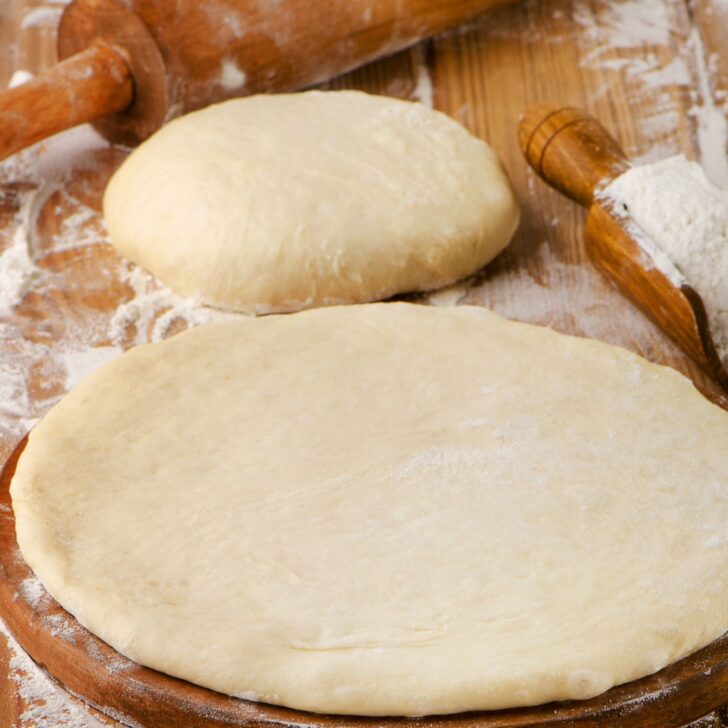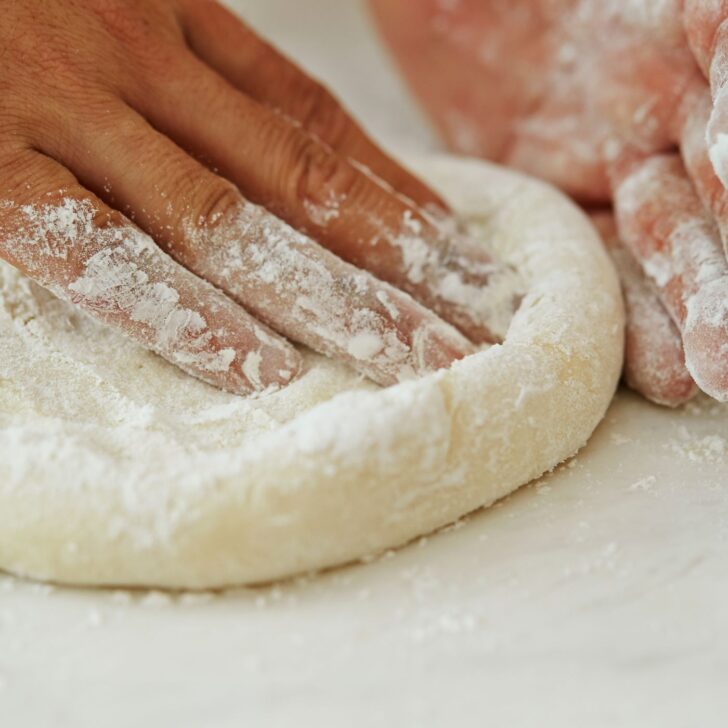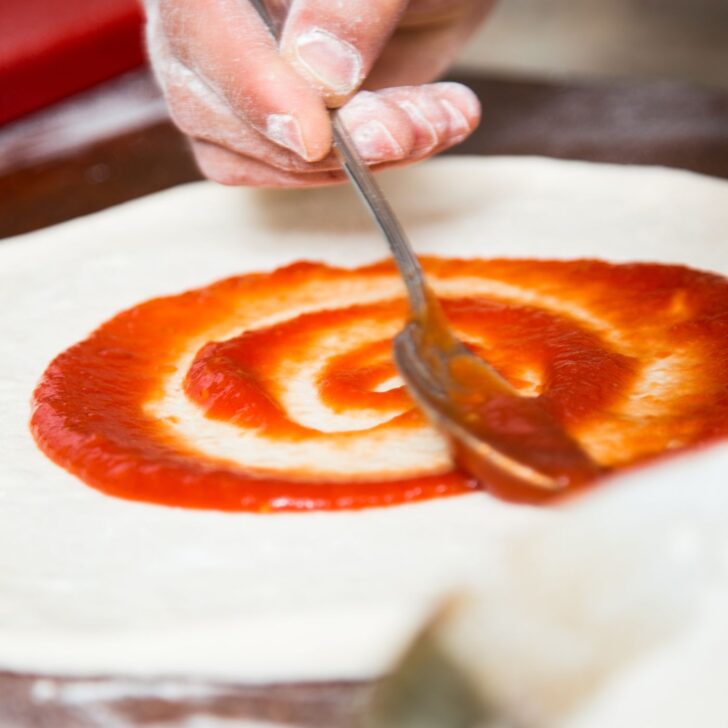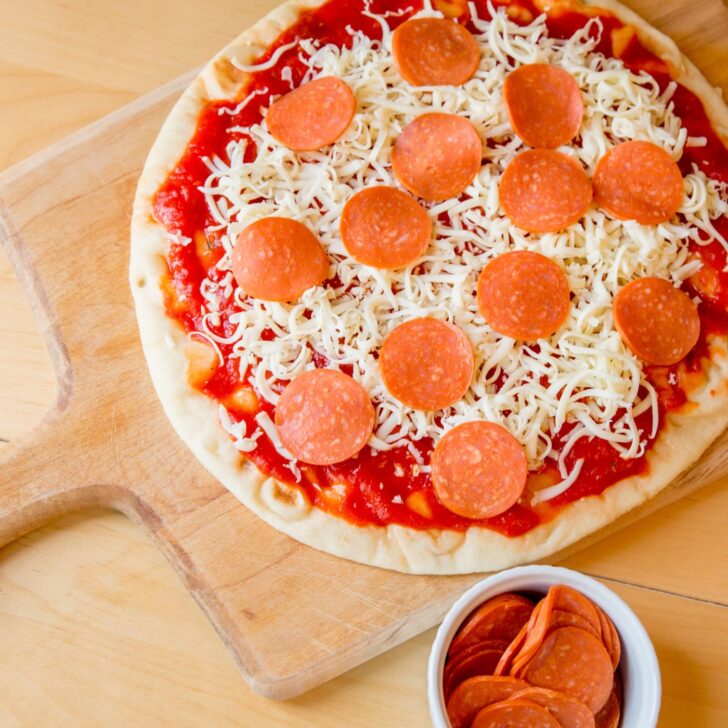Embarking on the quest to craft the perfect pizza at home often begins with a crucial and sometimes daunting step: making the dough. Yet, what if I told you that achieving a pizzeria-quality base could be both straightforward and rewarding?
Welcome to the world of easy pizza dough, where simplicity meets deliciousness in every bite. This guide is designed to demystify the process of dough making, proving that you don’t need to be a seasoned chef to create a delightful pizza foundation.
From quick family dinners to impromptu gatherings with friends, mastering an easy homemade pizza dough recipe is your ticket to enjoying homemade pizza anytime the craving strikes.
Let’s roll up our sleeves and dive into the satisfying journey of turning a few simple ingredients into the perfect canvas for your favorite toppings.
Whether you’re a pizza-making novice or looking to refine your skills with new tips and techniques, this pizza making guide promises to elevate your home cooking experience, one pizza at a time.
Table of Contents

Understanding Pizza Dough Ingredients
Diving into the realm of pizza dough, the magic of making pizza dough lies in the simplicity and quality of its ingredients. Mastery of these components is not just beneficial; it’s essential. Here’s the straightforward breakdown:
Basic Ingredients for Easy Pizza Dough
- Flour: The backbone. High-protein flour, like bread flour, offers structure and chewiness. For a lighter crust, all-purpose flour is a viable alternative.
- Water: The hydrator. Water activates the yeast and binds the flour into dough. Temperature matters – warmth is crucial for yeast activation.
- Yeast: The lifter. Yeast is responsible for fermentation, giving the dough rise and flavor. Options include active dry yeast and instant yeast.
- Salt: The enhancer. Salt strengthens gluten structure and enhances flavor. It’s not just seasoning; it’s a crucial component of the dough’s texture.
- Olive Oil (optional): For richness and tenderness. Olive oil is a common choice, adding flavor and aiding in the dough’s moisture retention.
The Role of Yeast in Pizza Dough
- Fermentation: Yeast consumes sugars in the flour, producing carbon dioxide gas and alcohol. This gas is what causes the dough to rise, creating lightness and structure.
- Flavor Development: The fermentation process also develops complex flavors within the dough, contributing to the signature taste of great pizza crusts.
- Texture: Proper yeast fermentation leads to a dough that’s stretchy and pliable, making it easier to shape into your desired pizza base.
Understanding the role and balance of each ingredient in pizza dough is crucial. Each element contributes to the final texture, flavor, and appearance of your pizza. The science of making pizza dough is simple yet profound, with yeast acting as the critical agent that brings life to a mixture of basic ingredients. This is the alchemy of pizza-making: transforming wheat flour with water, yeast, and salt into a canvas for culinary creativity.
The Basics of Working with Active Dry Yeast
Active dry yeast is a cornerstone of traditional pizza dough, a catalyst that transforms the dough into a light, airy base for your toppings. Understanding how to handle this ingredient is crucial for any aspiring pizza maker. Here’s a straightforward guide to working with active dry yeast:
What Is Active Dry Yeast and How It Works
- Definition: Active dry yeast consists of dehydrated granules of live yeast. Each granule contains yeast cells encased in a shell of dried yeast.
- Activation: Before use, active dry yeast needs to be rehydrated and activated. This process “wakes up” the yeast, readying it for dough making.
- Function: Once activated, yeast feeds on the sugars in the flour, producing carbon dioxide gas and alcohol, which causes the dough to rise and develop flavor.
Preparing Yeast for Your Pizza Dough
- Step 1: Proofing the Yeast
- Dissolve 1 teaspoon of honey in 1/2 cup of warm water (105°F to 115°F). Sprinkle 2 teaspoons of active dry yeast over the surface.
- Let the mixture stand for 5 to 10 minutes. A foam or froth on the surface indicates that the yeast is active and ready to use.
- If no foam forms, the yeast is dead. Discard and start over with fresh yeast.
- Step 2: Mixing with Flour
- Once the yeast is proofed, add it to your flour mixture according to your pizza dough recipe.
- Ensure the rest of the water you add is also warm to maintain the right environment for the yeast to continue working.
- Step 3: Kneading and Rising
- Knead your dough until smooth and elastic. The activated yeast will begin to ferment the sugars in the flour, producing gas that gets trapped in the gluten network.
- Let the dough rise in a warm, draft-free area until it doubles in size. This usually takes 1 to 2 hours but can vary depending on the recipe and environment.
Tips for Working with Active Dry Yeast
- Temperature Matters: Too hot water can kill yeast cells, while too cold water won’t activate them. Use a kitchen thermometer for accuracy.
- Sugar Aids Activation: The small amount of sugar helps “feed” the yeast during proofing, speeding up activation.
- Patience Pays Off: Allow enough time for the dough to rise properly. Rushing this process can result in dense, heavy pizza crusts.
Mastering the use of active dry yeast is a fundamental skill in pizza dough preparation. By following these steps and tips, you’ll ensure your own dough rises and has the perfect texture and flavor, serving as a delicious foundation for whatever pizza sauce and toppings your heart desires.

Best Pizza Dough Recipe with Active Dry Yeast
Traditional pizza dough, revered for its flavor and texture, owes much of its character to the fermentation process initiated by active dry yeast. Here’s a direct approach to making traditional pizza dough using active dry yeast:
Ingredients for Traditional Pizza Dough
- 14 oz all-purpose or bread flour (~4 cups)
- 1 tablespoon honey (to feed the yeast)
- 1 tablespoon active dry yeast
- 1 teaspoon salt (for flavor and to strengthen gluten structure)
- 1 cup warm water (temperature around 110°F to activate the yeast)
- 2 tablespoons olive oil (for dough elasticity)
Step-by-Step Guide: Mixing, Kneading, and Rising
- Step 1: Proof the Yeast
- Dissolve honey in warm water. Sprinkle yeast over the surface. Let stand until frothy (about 5-10 minutes), indicating the yeast is active.
- Step 2: Mix Ingredients
- In a stand mixer with a dough hook, combine flour and salt. Add the frothy yeast mixture and olive oil. Stir until a shaggy dough forms.
- Step 3: Knead the Dough
- Turn the mixer up to medium speed. Knead with the dough hook for about 10 minutes, adding flour as necessary, until the dough is smooth and elastic.
- Step 4: First Rise
- Place the dough in a lightly oiled bowl, covering it with a damp cloth. Let it rise in a warm, draft-free area until doubled in size.
- Step 5: Punch Down and Shape
- Once risen, punch the dough down to release gas bubbles. Divide it if making multiple pizzas, then shape each portion into a ball. Let the balls rest for a few minutes before rolling out.
Easy Pizza Dough
This easy pizza dough recipe is your ticket to homemade pizza nights that are both simple and satisfying. Crafted for beginners and seasoned cooks alike, this recipe brings the pizzeria experience into your kitchen with minimal fuss and maximum flavor.
Ingredients
- 14 oz bread flour (~4 cups)
- 1 Tbsp active dry yeast
- 1 cup warm water
- 1 Tbsp honey
- 1 tsp salt
- 2 tbsp olive oil
Instructions
- Activate the Yeast: In a small bowl, dissolve the honey in warm water. Sprinkle the active dry yeast over the top. Let stand for 5 minutes, or until the mixture is frothy.
- Mix the Dough: In the bowl of a stand mixer fitted with the dough hook attachment, combine the yeast mixture with the bread flour, olive oil, and salt. Mix on low speed until a dough starts to form.
- Knead the Dough: Increase the speed to medium and knead the dough for about 7-10 minutes, or until it’s smooth and elastic.
- First Rise: Lightly grease a large bowl with olive oil. Place the dough in the bowl, turning it to coat all sides with oil. Cover with a damp cloth or plastic wrap and let it rise in a warm place for about 1 hour, or until doubled in size.
- Preheat the Oven: Place a pizza stone in the oven and preheat to 475°F (245°C) for at least 30 minutes before baking.
- Shape the Dough: Punch down the risen dough and turn it out onto a lightly floured surface. Divide the dough in half and shape each piece into a ball. Let them rest for a few minutes. Then, stretch or roll out into a thin round.
- Add Toppings and Seasonings: Lightly flour a pizza peel. Place the stretched dough onto the peel. Spread your chosen sauce evenly over the surface, leaving a small border around the edge. Add a layer of cheese, then arrange your toppings of choice on top. Finish with a sprinkle of seasonings like dried oregano, basil, or red pepper flakes for extra flavor.
- Bake the Pizza: Slide the pizza from the peel onto the preheated pizza stone. Bake for 10-15 minutes, or until the crust is golden brown and the cheese is bubbly.
- Serving: Remove the pizza from the oven using the pizza peel. Let it cool for a few minutes before slicing and serving.
Notes
- Water Temperature: Ensure the water is warm to touch but not hot, to activate the yeast without killing it.
- Dough Hydration: If the dough seems too dry, add a little more warm water, one tablespoon at a time, until the desired consistency is reached.
- Baking Surface: A pizza stone distributes heat evenly, but a preheated baking sheet can be used as an alternative.
Recommended Products
As an Amazon Associate and member of other affiliate programs, I earn from qualifying purchases.
Nutrition Information
Yield 16 Serving Size 1 SliceAmount Per ServingCalories 111Total Fat 2gSaturated Fat 0gTrans Fat 0gUnsaturated Fat 2gCholesterol 0mgSodium 147mgCarbohydrates 19gFiber 1gSugar 1gProtein 3g
How Long to Let Your Pizza Dough Rise
- First Rise: Typically, the first rise should be about 1 to 2 hours. The exact time can depend on the temperature of your kitchen. The dough should double in size.
- Optional Second Rise: For even better flavor and texture, some recipes call for a second rise after the dough has been shaped into balls. This can be for an additional 30 minutes to 1 hour.
Additional Tips for Success
- Optimal Rising Temperature: Yeast is most active between 75°F and 85°F. Find a warm spot without direct sunlight for the best results.
- Visual Cues Over Time: Use the dough’s appearance and size to gauge readiness, rather than sticking rigidly to the clock.
- Pre-Bake for Thick Crusts: For thicker crusts, pre-bake the shaped dough without toppings for a few minutes to establish structure.
Creating traditional pizza dough with active dry yeast is a testament to the beauty and simplicity of baking. The process, marked by patience and attention to detail, rewards you with a crust that’s both flavorful and satisfyingly textured—a perfect base for your favorite toppings.
If you’re aiming to elevate your pizza game with a distinctive flavor, consider the journey into sourdough pizza crusts. Sourdough introduces a rich, tangy essence that sets your pizza apart from standard yeast doughs.
For those eager to explore this artisan technique, I’ve compiled a thorough guide on creating the perfect sourdough pizza crust. Venture into this culinary exploration and learn how to imbue your pizzas with the unique character of sourdough by checking out my detailed blog post on sourdough pizza crust.

Rolling Out Your Homemade Pizza Dough
Rolling out pizza dough is a critical step in achieving your desired pizza crust, whether you’re aiming for a thin, crispy base or a thick, chewy one. The technique used not only shapes the pizza dough, but also influences the texture and the overall eating experience of the pizza. Here’s a straightforward guide to rolling and shaping your pizza dough:
Techniques for Rolling and Shaping
- Let the Dough Rest: Before rolling, let the dough rest at room temperature for about 30 minutes. This makes it easier to shape as the gluten relaxes.
- Start with a Ball: Begin with your dough shaped into a smooth ball. This helps in achieving a uniform thickness.
- Use Your Hands: For a traditional approach, use your hands to gently stretch the dough from the center outward, rotating as you go to maintain a circular shape. This method is preferred for thinner crusts.
- Rolling Pin for Uniformity: For a more uniform thickness or for thicker crusts, lightly flour your surface and the rolling pin, then gently roll the dough to your desired thickness. Avoid rolling too thin if aiming for a thick crust.
- Air Bubbles Are Good: If aiming for a rustic, artisanal look, don’t worry about air bubbles that form while shaping. They add character and texture to the crust.
Thickness Matters: Thin Crust vs. Thick Crust
- Thin Crust:
- Roll or stretch the dough to about 1/8 inch thickness.
- Pre-baking isn’t usually necessary; a thin crust will crisp up quickly with toppings on.
- Aim for quick baking at high temperatures to ensure a crispy base.
- Thick Crust:
- Roll or shape the dough to about 1/4 to 1/2 inch thickness.
- Consider pre-baking the crust for 5-7 minutes before adding toppings to prevent it from becoming soggy.
- A thicker crust may require a slightly longer baking time at a marginally lower temperature to cook through without burning the outside.
Additional Tips
- Avoid Overworking: Over-rolling or excessive handling can make the dough tough. Work efficiently for the best texture.
- Flour Sparingly: Use just enough flour on your hands and the surface to prevent sticking. Excess flour can dry out the dough.
- Room for Expansion: Leave a small border around the edge untopped for the crust to rise and create that classic pizza edge.
- Consistency Is Key: Aim for even thickness to ensure uniform cooking. Irregularities can lead to undercooked or burnt sections.
Mastering the roll and shape of homemade pizza dough takes practice, but even first attempts yield delicious results. Whether you prefer pizza with a thin crust that snaps with each bite or a thick crust that offers a soft, chewy foundation for your toppings, the method of rolling out your dough sets the stage for your pizza’s final texture and flavor.

Adding Toppings to Your Pizza
Adding toppings to your pizza is where creativity meets technique. The right selection and arrangement of toppings not only enhance flavor but also ensure an even bake and perfect texture. Here’s how to approach this crucial step with precision and purpose:
Choosing the Right Toppings for Your Pizza
- Consider Moisture Content: High-moisture toppings like fresh tomatoes or certain cheeses can make your pizza soggy. Pre-cook or drain them if necessary.
- Balance Flavors: Pair toppings with contrasting and complementary flavors. Salty cured meats balance well with sweet pineapple or acidic tomatoes.
- Texture Variety: Include a mix of textures for a more interesting experience. Crispy vegetables, creamy cheeses, and chewy meats are a good start.
- Quality Matters: Use fresh and high-quality ingredients for the best taste. This is especially important for simple pizzas with few toppings.

How to Layer Toppings for the Perfect Bake
- Start with the Sauce: Spread your sauce evenly, leaving a small border around the edge for the crust. Avoid over-saucing to prevent a soggy base.
- Add Cheese: Cheese goes on top of the sauce for most pizzas. It acts as a barrier, keeping other toppings from becoming dry under the heat.
- Distribute Meats and Vegetables: Spread these toppings evenly over the cheese. Ensure meat is cooked and vegetables are sliced thinly for even cooking.
- Final Touches: Ingredients that burn easily or are used for their fresh flavor, like certain herbs, are best added after baking or in the last few minutes of cooking.
Thin Crust vs. Thick Crust Toppings
- Thin Crust:
- Keep toppings light to prevent overwhelming the delicate base.
- Quick-cooking or pre-cooked toppings are ideal to match the shorter baking time.
- Thick Crust:
- Can support heavier, more robust toppings and multiple layers.
- Good for slower-cooking toppings, as the thicker base requires a longer baking time.
Additional Tips
- Preheat the Oven and Baking Surface: A hot oven and a preheated pizza stone or baking sheet ensure a crisp bottom and evenly cooked toppings.
- Consider Cooking Times: Some toppings may cook faster or slower than others. Pre-cook ingredients with longer cooking times to ensure everything is perfectly done at the same time.
- Spacing: Avoid overcrowding your pizza with toppings. Too many toppings can lead to uneven cooking and a soggy center.
Mastering the art of topping a pizza requires attention to detail and an understanding of how each element contributes to the final product. By selecting the right toppings and layering them thoughtfully, you ensure a harmonious balance of flavors and textures, resulting in a pizza that’s as delightful to eat as it is to look at.

Baking Your Pizza to Perfection
Baking your pizza to perfection is a critical step where precision meets practice. The right oven environment and proper baking technique are pivotal in any pizza crust recipe achieving that irresistible blend of a crispy crust and perfectly melted toppings. Here’s how to nail the baking process every time:
Preparing Your Oven for Pizza Baking
- Preheat the Oven: Heat your oven to its highest setting, typically between 475°F to 550°F (245°C to 288°C), at least 30 minutes before baking. This ensures a super-hot environment, crucial for a crispy crust.
- Use a Pizza Stone or Steel: These retain heat and mimic the floor of a pizza oven better than a pizza pan. Place it in the oven during the preheating phase.
- Positioning: For pizza stones or baking sheets, position them on the lowest rack to get the bottom of the pizza as close to the heat source as possible.
Baking Times and Temperatures for the Perfect Crust
- Thin Crust Pizza:
- Bake at the higher end of your oven’s temperature range for about 5-7 minutes.
- The goal is a crispy base and lightly charred edges without overcooking the toppings.
- Thick Crust Pizza:
- Lower temperature to around 425°F to 450°F (218°C to 232°C).
- Bake for 15-20 minutes, allowing the thicker dough more time to cook through without burning the toppings.
Additional Baking Tips
- Oven Rack Placement: Besides using the lowest rack for heat concentration, experiment with your oven’s hot spots for even baking.
- Rotating the Pizza: Halfway through baking, rotate the pizza 180 degrees to ensure even cooking, especially in ovens with uneven heat distribution.
- Pre-Baking: For thicker crusts, consider pre-baking the dough for 3-5 minutes before adding toppings. This can prevent sogginess.
- Monitoring: Keep a close eye on the pizza during the final minutes of baking. The transition from perfectly done to overcooked can happen quickly.
Achieving the perfect bake for your pizza requires understanding your oven’s characteristics and adjusting the baking process to suit the type of pizza you’re making. By preparing your oven correctly and monitoring the pizza closely as it bakes, you can ensure a deliciously crispy and golden brown top crust every time.
Troubleshooting Common Pizza Dough Problems
Navigating the path of homemade pizza dough preparation can sometimes lead to unforeseen challenges. Understanding how to address common issues ensures your endeavor yields success, not stress. Here’s a straightforward approach to troubleshooting common pizza dough problems:
Dealing with Sticky or Too Dry Dough
- Sticky Dough:
- Add Flour: Incorporate more flour, a little at a time, until the dough becomes less tacky and easier to handle.
- Check Humidity: High humidity can make dough stickier. Adjust flour and water ratios slightly on humid days.
- Use Oil on Hands and Surface: Lightly oil your hands and the surface when handling sticky dough to prevent sticking without adding too much extra flour.
- Too Dry Dough:
- Add Water: Introduce a small amount of water gradually until the dough reaches the desired consistency.
- Knead Thoroughly: Sometimes, dough appears dry because it hasn’t been kneaded long enough for the water to fully hydrate the flour.
- Cover During Rest: Prevent dough from drying out by covering it with a damp cloth during rest periods.
What If My Dough Won’t Rise?
- Temperature Check: Ensure the dough is resting in a warm area. Cold environments can significantly slow down yeast activity.
- Yeast Viability: If the dough does not rise, the yeast might be old or inactive. Always proof yeast (if using active dry yeast) to ensure it’s alive and ready to work.
- Patience Is Key: Some doughs, especially those made with less yeast for a slow rise, take longer. Give it more time, especially in cooler conditions.
- Salt Proximity: Adding salt directly onto the yeast can inhibit its activity. Ensure it’s well mixed with the flour before adding yeast.
Additional Tips
- Flour Type Matters: Using the right type of flour can significantly affect the dough’s hydration and gluten development. Bread flour absorbs more water than all-purpose flour.
- Measuring Precision: Use a kitchen scale for ingredients if possible. Precision matters greatly in baking.
- Yeast Storage: Store yeast in a cool, dry place or in the refrigerator to extend its shelf life.
Addressing these common homemade pizza crust recipe dough issues requires a blend of patience, technique, and sometimes, a bit of experimentation. Understanding the underlying causes enables you to adjust your process, ensuring your homemade pizza dough recipe is on the right track towards achieving the perfect base for your culinary creations.
Store and Freeze Pizza Dough
Proper storage and freezing of homemade pizza dough are crucial for maintaining its quality and extending its usability. Here’s a direct, efficient guide to handling your pizza dough before and after freezing:
How to Store Unused Pizza Dough
- Refrigerator Storage:
- Lightly oil the surface of your dough ball to prevent drying out.
- Place the dough in a large enough container to allow for some expansion, or wrap tightly with plastic wrap.
- Store in the refrigerator for up to 48 hours.
Tips for Freezing and Thawing Homemade Pizza Dough
- Freezing:
- Divide the dough into portions you’d typically use for a single pizza.
- Lightly oil each dough ball.
- Wrap each portion tightly in plastic wrap, then place in a freezer bag or an airtight container to prevent freezer burn.
- Label with the date. Dough can be frozen for up to 3 months.
- Thawing:
- Transfer the dough to the refrigerator the night before you plan to use it, allowing it to thaw slowly.
- Remove the dough from the refrigerator and let it come to room temperature, about 30 minutes before you plan to use it. This step is crucial for ease of shaping.
- If in a hurry, the dough can be thawed at room temperature for a few hours. Keep it covered to prevent drying.
- Post-Thaw Handling:
- Once thawed, dough may be a bit more sticky due to moisture loss. Lightly flour your hands and working surface when handling.
- If the dough resists stretching, let it rest for an additional 10-15 minutes at room temperature. This allows the gluten to relax and makes shaping easier.
Storing and freezing homemade pizza dough with proper technique ensures you have high-quality dough ready for your next pizza adventure. Whether you’re planning ahead or saving leftover dough to make pizza again, these steps will help the frozen pizza dough retain its texture and flavor, making your next pizza just as delicious as if the dough were fresh.
Final Thoughts and Encouragement
Concluding this easy pizza dough recipe, it’s crucial to remember that making the best pizza dough at home is more than just a culinary endeavor; it’s a journey of creativity, patience, and learning. Here are some final thoughts and words of encouragement:
- Practice Makes Perfect: Your first pizza might not be flawless, but each attempt brings you closer to mastering the craft. Embrace the learning curve.
- Experiment Freely: Don’t be afraid to try new topping combinations, adjust dough thickness, or experiment with different flours. Personalization is key to finding what you love.
- Patience Pays Off: From allowing your dough to rise properly to preheating your oven, patience in each step ensures a better final product.
- Learn from Mistakes: Every pizza, whether a success or a slight disappointment, teaches you something. Reflect on what worked and what didn’t for next time.
- Share the Experience: Pizza making is an excellent activity for families and friends. Share the process, the successes, and the not-so-perfect outcomes. It’s all part of the fun.
- Celebrate Your Efforts: Take pride in the effort of making pizza from scratch. It’s an accomplishment worth celebrating, regardless of the outcome.
As you continue on your pizza-making journey, remember that the ultimate goal is not just a perfect pizza but the joy and satisfaction derived from the process of creating something delicious and sharing it with others. Keep pushing the boundaries of your own pizza dough adventures, and let each pizza you make be a reflection of your creativity and passion for good food.






